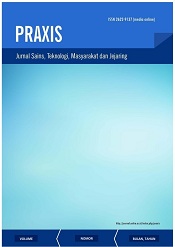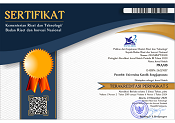Perkembangan Industri Furnitur Kabupaten Jepara Serta Kaitannya Dengan Potensi Penerimaan Pajak
Abstract
Keywords
Full Text:
PDFReferences
Badan Pusat Statistik (BPS) Kabupaten Jepara. (2019). Produk Domestik Regional Bruto Kabupaten Jepara, Retrieved from bps.go.id
Badan Pusat Statistik (BPS) Kabupaten Jepara. (2019). Daerah Dalam Angka Kabupaten Jepara. Retrieved from bps.go.id
Badan Pusat Statistik (BPS) Kabupaten Jepara. (2001). Tabel I-O Kabupaten Jepara Tahun 2001. Retrieved from bps.go.id
Badan Pusat Statistik (BPS) Kabupaten Jepara. (2008). Tabel I-O Kabupaten Jepara Tahun 2008. Retrieved from bps.go.id
Cooper, D.R, dan C.W., Emory. (2001). Business Research Meyhods, 8th Edition. USA: Richard D. Irwin Inc.
Direktorat Jenderal Pajak. (2017). Laporan Kinerja Kementerian Keuangan Republik Indonesia Direktorat Jenderal Pajak Tahun 2017. Retrieved from www.kemenkeu.go.id
Direktorat Jenderal Pajak. (2018). Laporan Kinerja Kementerian Keuangan Republik Indonesia Direktorat Jenderal Pajak Tahun 2018. Retrieved from www.kemenkeu.go.id
Mardiasmo. (2011). Perpajakan Edisi Revisi 2011. Yogyakarta: Andi Offset.
Marzuki. (2005). Metodologi Riset. Yogyakarta: Ekonisia.
Pujoalwanto, Basuki. (2014).. Perekonomian Indonesia Tinjauan Historis, Teoritis, dan Empiris. Yogyakarta : Graha Ilmu.
Resmi, Siti. (2009). Perpajakan : Teori dan Kasus. Jakarta : Salemba Empat.
Pemerintah Republik Indonesia. (2014). Undang-Undang Nomor 3 Tahun 2014 Tentang Perindustrian. Retrieved from kemenperin.go.id
Pemerintah Republik Indonesia. (2007). Undang-Undang Nomor 28 Tahun 2007
Tentang Ketentuan Umum dan Tata Cara Perpajakan. Retrieved from https://www.dpr.go.id
Pemerintah Republik Indonesia. (2008). Undang-Undang Nomor 36 Tahun 2008 Tentang Pajak Penghasilan. Retrieved from www.pajak.go.id
Waluyo. (2010). Perpajakan Indonesia. Jakarta: Salemba Empat
DOI: https://doi.org/10.24167/praxis.v2i2.2500
View My Stats | ISSN 2622-9137 (media online)







